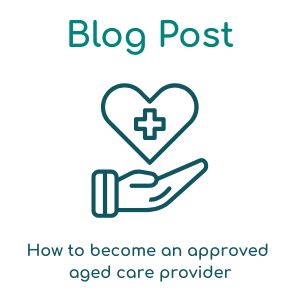
How to become an approved aged care provider
First published: May 2025
To become an approved aged care provider, which is an organisation that has been approved by the Department of Health and Aged Care to provide aged care services to the elderly population, a successful application must be submitted to the Aged Care Quality and Safety Commission.
Aged care services can be delivered in the form of:
- Residential aged care is for older people that can no longer live in their homes. After a successful approval, residential aged care homes need to be accredited by the government to receive funding.
- Home Care Packages offer support to older Australians to live within their homes for longer. These are tailored to the individual and help with complex care needs.
- The Short-Term Restorative Care (STRC) Program is an eight-week program designed to delay or avoid long term care, which includes a range of aged care services to assist with living independently and within aged care homes.
You can become an aged care provider for multiple areas and submit this in the same application, but the application fees will differ.
Approval process to become an aged care provider
Once decided on what type of care you would like to provide, the next step is to check your eligibility and apply. You cannot become an aged care provider if:
- You’re not an incorporated organisation
- You’re a sole trader
If you do not fall into these categories, you can proceed with your aged care provider application.
1. Prove your intent as an aged care provider
To become an aged care provider, you must prove that you are capable of providing aged care services and understand the laws and regulations surrounding the aged care industry. In your application you must:
- Explain what’s expected of you and your employees
- Understand the Aged Care Principles and Quality Standards
- Ensure those working in your organisation at all levels have experience working in aged care
Once you are sure your organisation is fit to deliver aged care services and become an aged care provider, your next step is to gather documents for key personnel within your business.
2. Documentation for your aged care employees and stakeholders
For every relevant individual attached to the organisation, you will need to provide the following:
- Security and character documents – Either a National Police Certificate (NPC), National Criminal History Check (NCHC) or a National Disability Insurance Scheme (NDIS) Worker Screening Check. These must be recent i.e less that 90 days old before the day you send in your application.
- Insolvency check
- Statutory declaration – Declaring: any former or current names not shown on their character checks, if they were a citizen/permanent resident of any other country after they turned 16, they’ve not been convicted of murder or assault of any kind, and their suitability as key personnel.
The definition of key personnel is any individuals who are employed, contracted or volunteers that provide nursing services and complete day to day operational tasks, and make executive decisions about the organisation and their activities. When providing details of your team, you must include someone who is responsible for the delivery of clinical care if you are applying for residential and/or home care. This person must be registered with the Australian Health Practitioner Regulation Agency (AHPRA)
3. Show financial viability to be a successful aged care provider
The aged care industry is partially reliant on government funding, with each aged care provider being able to apply for a subsidy when accredited. To become an aged care provider before you reach accreditation status, you need to display your ability to maintain a financial management system and that you have the necessary funds and investments.
Alongside funding, if you intend to use subcontractors then you are legally responsible for them and the services they provide. You must provide a copy of agreements with these organisations and how they will follow the Aged Care Quality Standards.
Applications can be submitted via the Aged Care Quality and Safety Commission website.
Fees to become an approved aged care provider
Unless you are intending to provide at least 85% of care and services in areas six and/or seven of the Modified Monash Model, you will need to pay for your application. The fees as of April 2025 are:
| Application type | Description | Fee |
| Single care | Applicants applying to provide one care type (e.g. residential aged care) | $9,070 |
| Two care types | Applicants applying to provide two care type (e.g. residential aged care and home care) | $10,530 |
| Three care types | Applications applying to provide all care types (e.g. residential aged care, home care and flexible care) | $12,270 |
| Government organisations | These are already approved to deliver all types of care and do not need pay a fee. They do need to register for approved provider status. | $0 |
If you application is incomplete, or further information is needed, a Request for Information can be sent. This will incur additional fees:
| Request for Information type | Description | Fee |
| Pre-assessment | Missing pages in document/missing information about key personnel | $235 |
| Initial assessment request: single care | More evidence needed for claims in application | $1,170 |
| Initial assessment request: two care types | More evidence needed for claims in application | $1,430 |
| Initial assessment request: three care types | More evidence needed for claims in application | $1,760 |
| Subsequent assessment request: single care type | More evidence needed for claims in application | $490 |
| Subsequent assessment request: two care types | More evidence needed for claims in application | $585 |
| Subsequent assessment request: three care types | More evidence needed for claims in application | $740 |
Approval process to become an aged care provider
The aged care provider approval process is broken down into four stages:
- Validity check – to determine the application is real, the attaching documents are relevant, and the invoice is legitimate. This can take up to ten business days.
- Initial assessment – checking your organisations Australian Securities and Investment Commission (ASIC) records, including key personnel, directors, shareholders and holding companies. Additional fees may be charged here if more information is needed. This can take up to ten business days.
- Formal assessment – a senior assessor reviews the application and drafts a recommendation to the delegate. This can take up to 90 days.
- Decision – The delegate reads the senior assessor’s recommendation and information provided by you. They will then decide the outcome of your application and will send you a decision within 14 days of it being made.
If changes are needed during the assessment, they are to be emailed to approvedproviderapplications@agedcarequality.gov.au
If your application to be become an aged care provider is refused
If your application is not approved, you can:
- Reapply
- Request a consideration
Reapplication will incur another fee. Requesting a consideration must be done within 14 days of receiving the written decision. If you wish to do this and 90 days has passed since the outcome, you will need to apply for an Administrative Appeals Tribunal. This will incur an application fee.
Want to become an approved aged care provider, or work for one?
Servicing the aged care industry since 2015, the team at Sanctuary Recruitment are experts in the aged industry. For more information on working in aged care or delivering aged care services, contact our team today.


